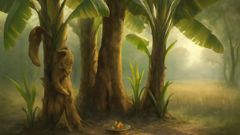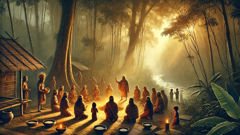Introduction
At the edge of paddy fields, where the earth still remembers flood and sun, the wild banana stands like a guard of green. Its leaves are broad hands that catch rain and birds, its trunks wrapped in the tender decay of dying sheaths, and within that layered heart some households say a world is lodged. Nang Tani is that world’s hush: a female spirit bound to the solitary wild banana tree, at once luminous and full of the ancient, animal caution. In villages, older men nod when they hear hissing tires on an empty road and whisper her name to steady frightened children. Farmers leave small offerings—slices of ripe banana, a smudge of rice, a smear of sweet coconut jam—at the base of an uncut banana clump, because even the most quarrelsome neighbors know that some things in the country are kept from human law. The legend shifts with seasons. In damp rains, she is said to be more merciful, her green robe damp with dew as she soaks the grief of those who have been wronged. In harvest drought, when people have grown thin with worry, some say Nang Tani’s face sharpens like a blade, and she will take vengeance on men who take what is not theirs. This story does not pretend to capture every telling—there are as many Nang Tanis as there are small groves by the road—but it gathers a long view: the origin in sorrow and the way a spirit threads into ordinary lives, a presence that teaches respect for nature, warns against cruelty, and retains a stubborn tenderness for those who treat the land and one another well.
Origins and Echoes: Where Nang Tani Began
The origin stories of Nang Tani are braided like the layers of a banana sheath: soft, repeating, never quite the same twice. One common thread tells of a woman who died unjustly—abandoned by a lover, wronged by a landlord, lost to illness without a proper funeral—and whose grief rooted her to the earth where a banana tree grew. Another version says she was a local spirit who always lived among the wild groves long before the village’s rice fields flattened the land; when settlers cleared the forest for planting, the spirit simply took refuge in the banana, one of the plants that the swiddening left behind. Oral traditions in Thailand are patient with contradictions: they're less concerned with chronological accuracy than with preserving the lesson. In both tellings, Nang Tani emerges from pain and becomes tangled with the tree, and so her moods, like the state of the soil, reflect how people treat one another and the land.

To the villagers, the wild banana grove is a marker on the map of daily living. It stands at the corner where paths fork, the place children dare one another to run after dark, and the soft boundary between the cultivated and the ungoverned. Because of its edge position, the banana tree is a natural meeting place for stories to accumulate: a traveler may leave a tale there as he will a pebble. When the rice is knee-deep, mothers caution the youngest to stay away from the grove, and elders lay small plates of food beneath the trunks as if to say please, be at peace. Anthropologists who have listened to these narrations describe a delicate ecology of respect. The offerings are never demanded; they are conversation. A plate of sweet sticky rice becomes a way to recognize that a household is aware of other claims on the land—claims older than title deeds, older than the village temple.
Legends often give Nang Tani two faces. In some accounts she is benevolent: she tends lost children, guides lonely travelers to the right path, and leaves the fields balmier, the soil less cracked. Her arrival might be signaled by the scent of bananas that do not grow on the tree or the sudden hush of crickets. In other retellings, she is a figure to fear. Men who cheat their neighbors, who steal from a poor household, or who fail to honor obligations to wives and kin are rumored to find themselves tripping at night on the embankment, seeing a slim woman in green whose laugh turns to wailing. There are stories, told in the lower voice that keeps children alert, where a man who carries off a woman’s honor, and then discards her, returns to find his home full of green leaves sticking from every corner, as if the banana’s patience has invaded his walls.
These dualities—comfort and menace, tenderness and retribution—aren’t accidental. They serve as social education in a place where community bonds matter for survival. The threat of an offended spirit keeps behavior within a moral circumference wider than a courthouse. In simpler terms, learn to act right by the earth and your neighbors, or suffer consequences no law can fully predict. That the spirit is tied to a banana tree, not a temple or a riverside shrine, suggests the sacredness of ordinary plants, of the unmemorable things that sustain a village: the shade where elders nap, the sheath that feeds pigs, the leaves that wrap parcels of sticky rice. The legend says: if you can be kind to something as small as a banana stalk, you can be kind to a person.
The imagery surrounding Nang Tani is richly vegetal. She is described most often in a green chong kraben or a dress of banana-hued silk. Poetic speakers remark that at certain times her hair might glitter with dewdrops and that the folds of her robe move like new leaves unfurling. Yet her beauty is not decorative; it is a warning. The same green that soothes can also hide the sharpness of her teeth when angered. The banana tree itself is a symbol of cyclical life and human dependence; its clustered pups, ready to sprout into new trunks, echo the possibility of transformation. Nang Tani embodies that possibility—she can nurture or she can break what is thoughtless.
Across regions, the stories adapt. In some coastal villages, Nang Tani is conflated with river spirits; in other highland places she is a more solemn protector who helps with fertility. Folk artists render her sometimes as a full-bodied woman, sometimes as a hint—just the suggestion of a face within the leaves. When festivals come and Buddhist ceremonies weave through the year, Nang Tani is seldom the focus; she remains more private, a whisper between people than a public deity. Yet she is persistent. Even the modern young who attend school in town can recall hearing her name from a grandmother and feeling, briefly, that a wild patch of banana near a motorway might be more than weeds. There is a stubbornness to small beliefs like this: they endure because they are useful. They give a vocabulary for caution and comfort, a way to talk about those who have been mistreated, and a face for the quiet justice that the community wants but cannot always enforce. They also provide a language for longing—a grief that turns into a guardian who will not be ignored.
What follows are stories collected from different tellers: a widow who set out offerings and received a harvest, a young man who stole a bride’s dowry and woke to find his house overgrown with leaves, and several quieter accounts in which the spirit helps heal rifts between friends. These are not canonical tales; they are fragments that show how Nang Tani continues to live inside human choices. In the telling, the banana tree is a mirror, and the spirit that lives within reflects what we most need—comfort, accountability, or sometimes a way to grieve when there is no one else to do it for us.
Encounters and Lessons: Tales from the Embankment
Stories of encounters with Nang Tani walk the narrow edge between the plausible and the mystical. They begin with everyday details that anchor them: a lamp on a bicycle, the smell of frying fish, a chorus of frogs. From there the extraordinary is introduced with a casualness that makes it feel familiar: the faint sound of singing that has no source, the green-shaded hand that lifts a lost child's head, the smell of banana pastry where none was baked. One tale is told of Somchai, a rice harvester with hands like rope. He worked the field with a steady, patient muscle and respected the small claims of other people’s land. One year his harvest failed when a dry scratch of wind pressed through the paddy. Desperate, he planted his remaining seed where a clump of wild banana stood because the soil was different there, higher and cooler. He also left an offering beneath the tree because his grandmother once warned him never to take from what shelters life. The rice sown there grew tall and full—unlike any taken on the rest of his land. On the day of harvest, Somchai found a single green leaf draped over his sack like a blessing. He kept that leaf in his house for years. The neighbors who mocked him later borrowed seed from his shed when famine struck nearer lands. That neighborly exchange, the tale suggests, isn't simply a moral; it's practical economics with a guardian spirit watching the margins.

Another story is darker. A man named Kiet seduced a young woman who had recently lost her husband. He promised love and marriage, but after a moon she was left with a scorn that tasted of bitterness. Kiet took a job in a distant town and forgot the promises he made. The woman faded, and some said she died with grief. Kiet returned to the village a year later, content and careless. At night, while sleeping in his palm-thatched house, he awoke to the sound of leaves tapping his shutters. He saw, in the moonlight, a woman in green standing at the embankment, her hair moving like reed and her eyes full of the patience of plants. He laughed and called her by name, a fool’s familiarity. The next morning his house was covered in a thousand long, ribbon-like leaves. They had pushed through the mud and the thatch; they filled the bed and the cooking area and clogged the path to the well. Kiet's cattle died mysteriously, and his friends refused to help him. He learned, too late, that some broken promises cannot be mended with anger. The tale ends with the villagers burning the leaves and Kiet leaving the village in shame. In retellings, the severity of the spirit’s punishment varies; sometimes it's only humiliation, sometimes a loss so complete that the man must start a new life elsewhere.
Not all encounters are punitive. A narrative passed between women in one village talks about a bride, Nuan, who was robbed of her dowry the night before her wedding by a jealous cousin. The family’s joy turned to a small household crisis. In the early hours, while the family despaired, an old woman reported seeing a figure in green dancing at the embankment. By morning, the stolen coins were found wrapped in banana leaves and hidden beneath the tree. No one claimed the gesture. The cousins argued, the police were not involved, and the family quietly returned to the celebrations. The bride’s mother, who had seen her share of misfortunes, left a garland and a small bowl of coconut custard beneath the tree as thanks. That custom continues in small acts: offerings of things that are easy to make but meaningful to give, an economy of gratitude.
These stories also underscore the gendered ways in which Nang Tani is encountered. As a female spirit, her narratives often revolve around shame, betrayal, and the fragile securities of domestic life. This is not surprising: in rural communities where gender roles have historically been clearly delineated, a female spirit's intervention speaks directly to the spheres women navigate—marriage arrangements, dowry disputes, fidelity, and loss. Yet the spirit’s role is not limited to punishing men or protecting women; many stories also speak of her helping men who are humble and honest. A young boy who cared for his sick mother by bringing her banana leaves for medicinal poultices once fell asleep by the embankment and awoke to find his mother’s fever broken. A farmer who mended a neighbor’s water buffalo in secret later discovered his own field watered by unexpected rain. The moral is not simply about gender, but about an ethic of reciprocity: those who recognize debt to the land and to others are more likely to receive aid, even aid from the uncanny.
The way villagers respond to signs attributed to Nang Tani reveals the spiritual pragmatism characteristic of many rural communities. People do not always interpret a sighting in purely supernatural terms; they fold it into their daily calendars. If a woman sees a green figure on her way to the pump, she may make an offering that evening and avoid walking alone at dusk for a week as a sign of humility. If a local youth sees the spirit and is shaken by her presence, elders may advise him to apologize to anyone he has wronged and bring a bundle of sticky rice to the tree. The rituals are small and repeated: a bow, a whispered apology, a pinch of incense. They are less about securing permanent favor than about aligning the human and nonhuman communities so they can coexist. This pattern of behavior preserves social cohesion. It is easier to live beside people whose stories remind them to be careful with others—care that includes animals, plants, and the unmarked edges of a community.
Modernity complicates the story. Motorways cut through embankments, wild groves shrink under development, and banana clumps are cleared to make way for concrete. Yet the stories persist, moving into new mediums. Children now hear Nang Tani not only from elders but through illustrated booklets, blogs, and short films that reimagine her for urban audiences. These retellings often emphasize her aesthetic: the green dress, the luminous eyes. Some filmmakers turn her into a tragic heroine who suffers at the hands of men and yet chooses mercy. Others keep her as an ambiguous figure who resists being fully explained. The vitality of the legend stems from its adaptability: as the landscape changes, the spirit’s role shifts in response to contemporary anxieties—land loss, erosion of trust, and the speed of social change. The tales remain a way to speak about what people fear will be swallowed by progress: the fraying of neighborly obligations and the loss of places that keep memory and care alive.
Across all versions, Nang Tani’s presence functions as both mirror and teacher. She mirrors human actions—rewarding generosity, answering neglect with stern correction—and teaches a code of stewardship toward the living things that sustain a village. She turns the ordinary banana tree into a moral map: leave offerings and you might receive rain; break promises and you might find your life invaded by leaves. These are not magical economics; they're stories told so people remember to be attentive. And between the hush of the grove and the labor of the field, those small attentions build a communal resilience that modern maps and market transactions cannot register.
Conclusion
In the end, Nang Tani is less an isolated ghost story and more a living conversation between people and place. She asks villagers—and by extension all who listen—to consider how small acts of care, or small acts of disregard, ripple outward. When a child tucks a coin under banana leaves, it is gratitude spoken across species. When a man shrugs and clears a wild grove to make space for a shortcut, the spirit's warning becomes a cautionary tale passed down at a market stall. As contemporary development shifts the countryside and new lives sprout in towns far from the embankment, the stories continue to adapt, showing up in classrooms, in community festivals, and in late-night messages shared on phones. Sometimes Nang Tani is framed as metaphor, sometimes as an active spirit who walks the margin between humanity's order and nature's persistence. Either reading matters because both hold a lesson: that the land remembers, and that the relationships we keep with the living things around us define the terms for our well-being. The wild banana tree remains a simple sentinel—green and patient—while the spirit that lives there keeps reminding people that mercy and justice are often braided together like new leaves emerging from an old sheath. Wanderers who pass the embankment at dusk might think they’re simply seeing a trick of light; those who know the stories will slow down, make room, perhaps leave a small offering, and feel, just for a moment, part of a long ledger of obligations that holds a community in place.













